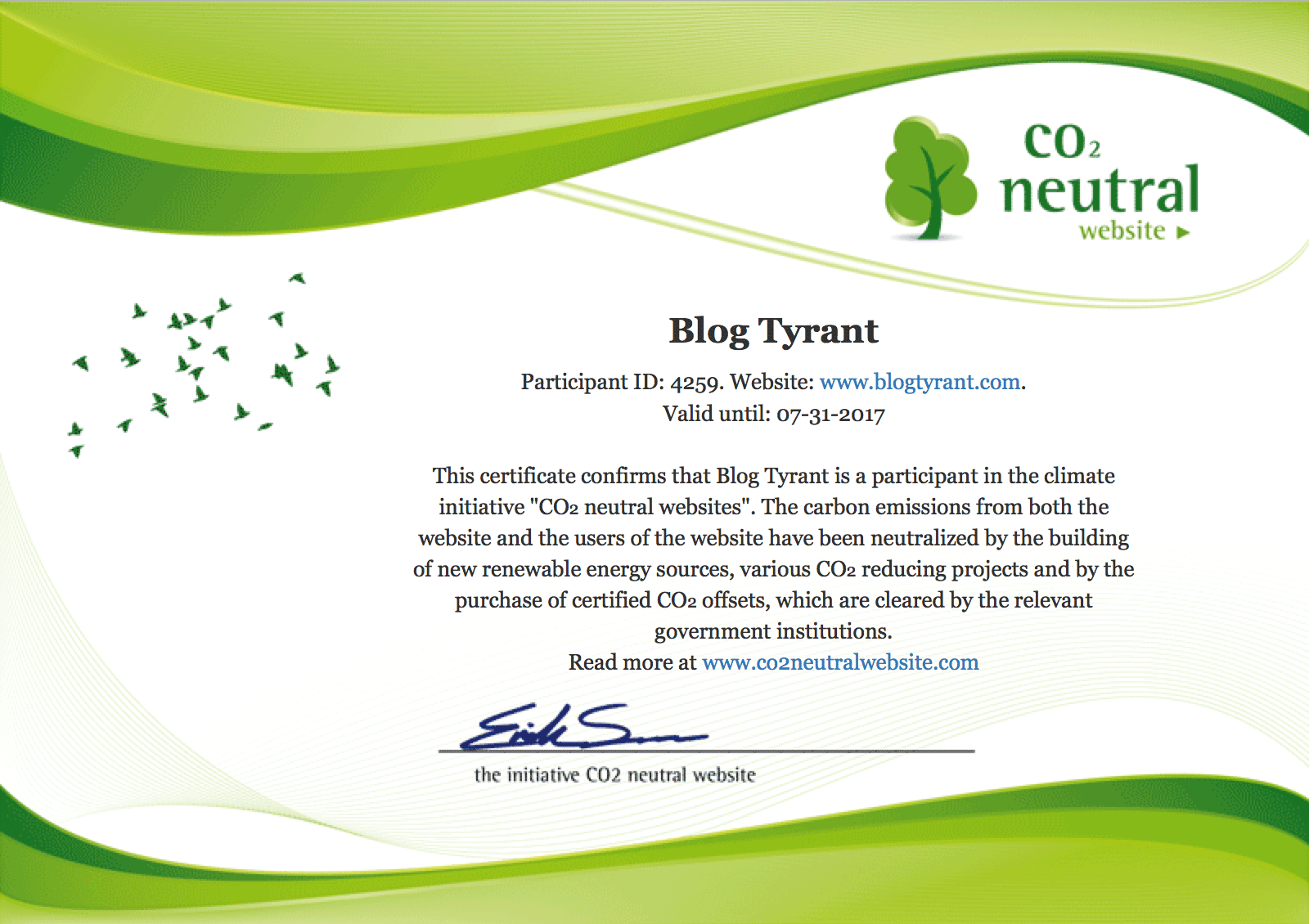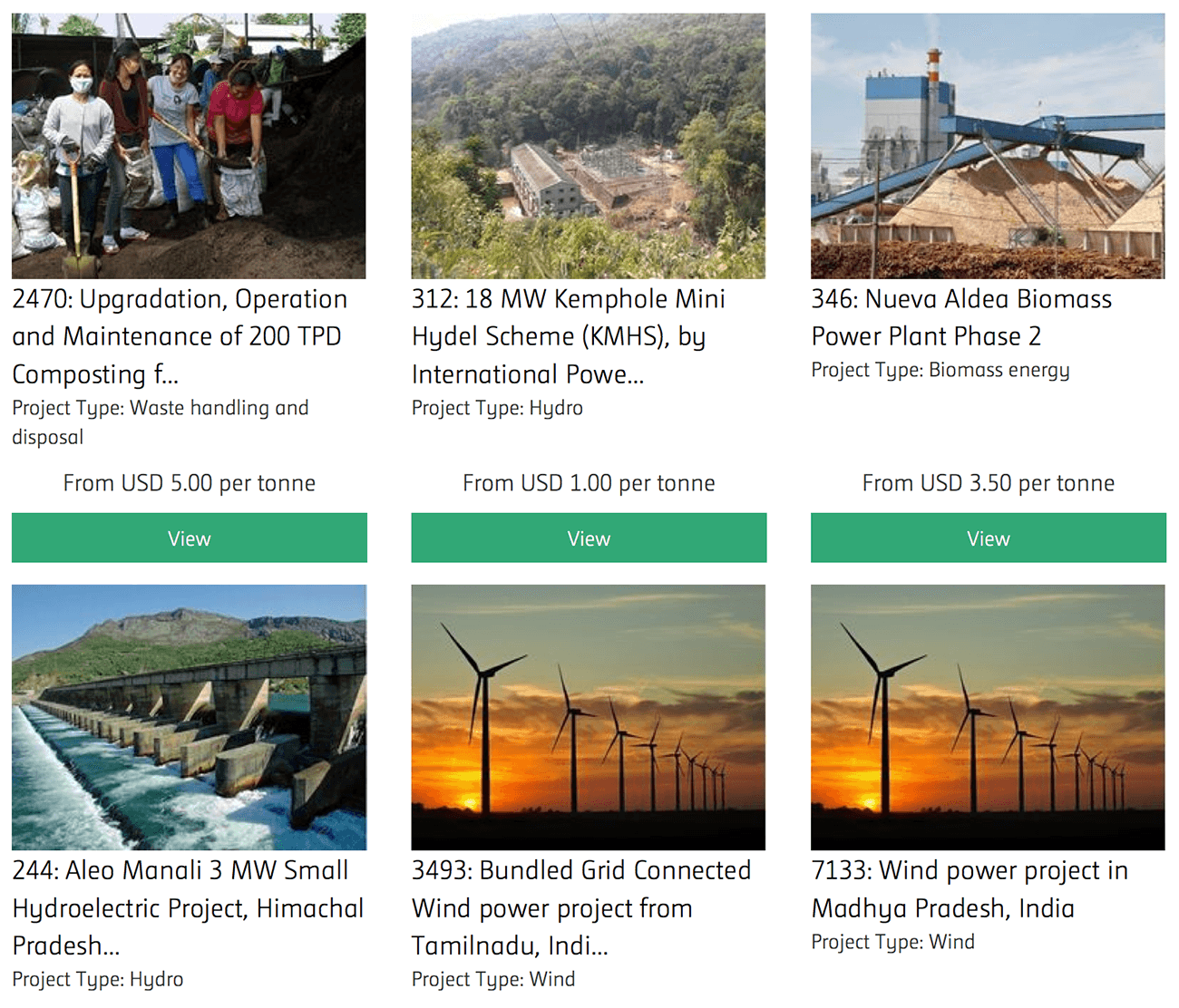
Every time someone visits your website a server somewhere needs power. More often than not that power comes from a “dirty” electricity source. Websites now produce a huge chunk of global greenhouse gasses.
Over a year we’re potentially talking tonnes of pollution into the atmosphere for each website that goes online.
It’s pretty frightening.
But there is good news: we can cheaply and effectively offset this carbon and make our websites much greener.
This post is designed to be a starting point for your own research and maybe a trigger for you to take some small action. Together we can make a difference, so please consider sharing it around.
Let’s do it!
Why is Blog Tyrant writing about this?
We all know that the environment is in trouble.
It’s been in trouble for a long time and, while there are some important breakthroughs, it seems like the progress is all too slow.
Although the science has been settled for ages now, there are still politicians and private companies who use misunderstandings and half-truths to muddy the issue and confuse people.
Some examples of this are seriously shocking.
As online business owners, we tend to think of ourselves as being pretty green. After all, we’re not driving trucks around or cutting down trees for palm oil, are we?
Unfortunately, however, our websites add to global pollution by having servers that are usually powered by either a mix of clean energy and dirty energy, or just dirty energy alone.
In fact, the IT industry now pollutes just as much as the airline industry. – Tweet this.
Seeing as Blog Tyrant helps a lot of people start blogs and build traffic, I’ve decided to step up and use some of my money and skills to offset my own impact, while also encouraging others to do the same.
Fortunately, it’s quite cheap to make a big dent.
If everybody who reads this post spends even $10 offsetting some carbon we’re talking about thousands and thousands of tonnes of pollution out of the atmosphere. What an amazing thing to do!
I’m really hoping you guys are down for this.
A quick overview of how websites create pollution
I had a graphic created to illustrate some interesting points about how much a website can pollute and how bad the problem really is. Let’s take a look:

Please consider sharing this graphic on social media or feel free to grab the code above and embed it on your own blog (I don’t care if you remove the links, they’re no_follow anyway). Getting the word out there is one small way we might be able to make an impact.
Now let’s get into some details, facts and stats.
So, how much does a website pollute?
Before I get into some of the solutions I thought it would be useful to take a look at how much pollution our websites and blogs are actually creating.
Unfortunately, while researching this issue, I found it almost impossible to get a consistent estimate of how much carbon was being produced.
I literally spent months investigating and couldn’t come up with a definitive and accurate answer – some companies refused to elaborate on their methods, others didn’t publish any at all!
Erik, the founder of CO2 Neutral Website, was by far the most helpful in explaining why it’s so difficult to find figures. Here’s an excerpt from our email conversations:
We did publish an average formula early on but we saw some companies phrasing: “Our website emits X tonnes of CO2,” based on our formula. But in some cases it was a false number. So what we have done is evaluate around 1,000 websites and taken the average number of 50% of the most polluting websites. We have then made sure our total calculation of needed compensation is higher than this number. That way we are very sure – but we just do not want specific companies to put a number on their site.
Not many companies were as forthcoming about their methods as Erik’s, and as such I haven’t mentioned them in the article.
From what I can tell, there are a few main factors that need to be looked at when assessing a website’s carbon footprint:
- The website’s traffic levels
The more traffic a website gets the more energy is needed to keep it online and access it. - The amount of time readers stay on your site
The longer visitors stay on your site the more power their computers use. - The types of devices used to access your site (laptops vs PCs, etc.)
Larger PCs are more inefficient than laptops, for example. - The types of servers your website uses
Some servers are more efficient than others, and some companies purchase carbon offsets. - The location of your readers
Some countries/states now have a percentage of renewable energy in their power supply. Readers in these locations will thus produce less carbon.
All of these things will impact that amount of energy that is required to power a website, but it’s impossible to be 100% accurate because there’s no way to know exactly what all of these numbers are.
For example, we can estimate how much energy a visitor on a PC will use to read your blog for five minutes, but if that reader has a massive 3-screen gaming rig then the CO2 is going to be significantly higher than average.
So how do we assess our own website’s pollution?
We need to rely on averages/benchmarks used by trusted organizations that are involved in the business of offsetting carbon around the world by supporting green projects.
Again, Erik was the most transparent about this:
On our website you can find the calculation behind the carbon offsetting, and our carbon offsetting is audited independently by the globally recognized accounting firm Deloitte. You will find that we compensate with many buffers in our calculations. So, in the end, our CO2 reductions are more than the emissions from the use of the websites. This is our decision as we want to be very sure that our participants in total deliver on their message, that they are CO2 neutral.
At this stage it seems like it’s only possible to get a very rough estimate about a website’s carbon emissions – but I’m starting to think that is okay as long as firms like Erik’s are making trustworthy compensations.
Looking elsewhere, I found Carbon Fund has a great breakdown of how they calculate their offsets while this website calculated 1,000 visitors a day be to around 2,160 kilograms (4,761 pounds) of CO2 per year. Other websites, however, indicate that this figure might be a little high.
Personally, I’m comfortable looking at a range of figures from a variety of sources and then assuming that my website is worse for the environment than it might be in reality. I think it’s better to err on the side of caution when it comes to climate change, especially as the offsets that we can purchase are relatively inexpensive.
I’ll show you what I decided to do for my business below.
How to make your website carbon neutral
You don’t need an exact number of CO2 output in order to do something and, luckily for us, we don’t have to go out and plant trees ourselves!
What we can do is pay a reputable organization to invest in green projects on our behalf. There are literally hundreds of amazing projects around the globe that have been specifically set up to help companies offset the damage that they do.
After researching the options available I decided to go with CO2 Neutral Website as a good starting point for making my website carbon neutral.
I was really impressed with their model, transparency and the way in which they simply and easily allow websites to offset their carbon, but also spread the word through a website icon (you can see it in my footer). Here is the certificate you get upon joining:

I then decided to engage the United Nations online platform for voluntary cancellation of certified emission reductions (CERs) in order to ensure that I am well and truly offsetting more than I am producing.
This website allows you to invest in and support wind, solar, hydro, re-forestation, etc. at a very low cost.

These projects work by canceling carbon credits so that you’re effectively taking a tonne of pollution off the table for every credit that you buy. They also have the added benefit of being beneficial to the local communities where these projects take place – a lot of them in developing countries.

I decided to purchase offset cancellations for 150 tonnes of CO2 here as a starting point for my research. This cost around $150 and was focused on wind projects in India.
I’ll continue to do this each month as I feel like it is a good way to spend some of the money that my company produces, and has become a regular part of our charity donation mix.
So, what can I do next?
If you’ve been inspired by this post then here are a few things you can do online right now that will have an impact on not only your own website, but the other websites that you use every day:
- Share this post
If enough people share this article we can get some traction on social networking sites and then, hopefully, get in front of more influencers who can then push it further. A quick Facebook post could go a long way. - Join CO2 Neutral Website today
As far as I can tell, this is a really good place to offset some carbon and spread the world by placing a graphic on your website that says you’re carbon neutral. If you can’t afford it (maybe take a look at some ways to make money online as well) then move on to the next option. - Purchase some voluntary cancellations
Use the United Nations online platform for voluntary cancellation of certified emission reductions (CERs) and pledge to keep making small donations here and there when you can. - Look at other projects like Solar Aid
Other companies like Solar Aid help fight climate change by selling solar lamps and chargers in Africa so as to prevent the use of kerosene lamps and dirty home generators. This also has wonderful benefits for the community and is cheaper to donate. - Email your web host
Some hosting companies benefit the environment by purchasing carbon offsets and using efficient cooling processes, others do absolutely nothing. Email your web host’s management and put polite pressure on them to step up on their commitment to climate change and purchasing offsets. Customer pressure is a big impetus for corporate change. - Pressure your service providers
Think about all the cloud-based services you use each day. Your mailing list storage, file sharing like DropBox and iCloud, entertainment like Spotify and Netflix. As paying customers of these services you have a voice. Get on public social networking sites and ask what they are doing to address their carbon footprint.
Quick tip: Donations to these types of organizations will sometimes be tax deductible depending on your local tax laws. Talk to your accountant and see whether you are able to claim them or any portion at tax time.
And don’t forget all the offline things we can do as well:
- Eat less meat (even one meal a day)
Going vegetarian halves your diet’s carbon footprint so if you do it even one extra day a week you’ll massively benefit the environment over your lifetime. - Call your Congressperson and then vote accordingly
Phone calls do a lot more than emails when it comes to government policy. Call your local members and tell them that a climate policy needs to be prioritized if they are going to win your vote. And make sure you vote accordingly. This is a huge economic, security and social issue we need to tackle. - Switch to renewable energy at home
Most energy providers now allow you to pay a slightly higher supply cost to get more of your electricity from renewable sources. As more people do this more money will go into those projects and costs will come down. Ring your provider and ask what’s available and if it’s not, switch. You’ll get a good deal. - Don’t upgrade (in fact, downgrade)
Do you really need that iPhone 6s+ when you’ve already got the 6? Do you even really need to upgrade every time your phone plan allows for it? The carbon emissions required to make something new (like a phone, laptop, PC, car, TV, etc.) are astronomical, far higher than the actual emissions associated with running the thing. I got rid of my massive gaming rig PC for a laptop, and have run my online company from two laptops in a decade, and one of those was second hand. I don’t need the latest.
These are just the tip of the melting iceberg – there are so many things we can do in our day to day lives. As I said at the top of the post, I’m just hoping this article serves as a starting point.
Will you get on board?
If you feel inspired to take some action for your own website then why not leave a comment below and make it public? I think it could be really inspiring to see that other people in our community making websites carbon neutral.
I’m lucky enough to be able to spend some of my income on offsets and related charities. I’ll continue to do that while also promoting this article to try and get as many people on board as possible. Hopefully it’ll have some small effect.
Please share this post around and let me know your thoughts below.
How to Make Your Website Carbon Neutral (BTW, it’s Really Easy) originally posted at Blog Tyrant
No comments:
Post a Comment